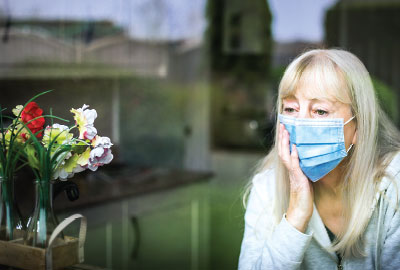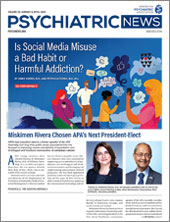Abuse of Older People Increases During Pandemic
Abstract
One in five older adults report experiencing physical, emotional, or financial mistreatment.

Most studies and news stories about COVID-19 and older people have focused on risk, infection, and mortality rates, but the pandemic has had another devastating impact on this population, one that is less visible, frequently ignored, and often a source of stigma: elder abuse. A study in the American Journal of Geriatric Psychiatry suggests that 1 in 5 older people has experienced elder abuse during the pandemic, a jump of nearly 84% over pre-pandemic estimates.
“We know that violence tends to surge during social unrest and troubled times, especially abuse that happens behind closed doors. Elder abuse is no exception,” lead author E-Shien Chang, M.Phil., told Psychiatric News. She is a fifth-year doctoral candidate in the Department of Social and Behavioral Sciences at Yale School of Public Health.
Chang and her colleague, Becca R. Levy, Ph.D., a professor of epidemiology at Yale School of Public Health and a professor of psychology at Yale University, conducted a survey of 897 people aged 60 years and older via two online platforms from April 23 through May 5, 2020, when all states had stay-at-home orders. Drawing from the Hwalek-Sengstok Elder Abuse Screening Test and the Vulnerability to Abuse Screening Scale, the researchers created a 10-item elder abuse assessment and asked participants if they experienced any of 10 possible incidents of elder abuse since the beginning of the pandemic. The incidents included whether someone close to them tried to hurt or harm them, no one wanted them around, whether they were afraid of someone in the family, whether someone had taken their money or belongings without their consent, and other indicators of abuse.

Every health professional who treats older patients should screen them for elder abuse, says E-Shien Chang, M.Phil.
The researchers then compared their results with those of two other studies that were conducted before the pandemic: the National Elder Mistreatment Study (NEMS), which reported on the prevalence of elder abuse in 5,777 people between 60 and 97 years old, and a survey conducted by investigators in the National Social Life, Health, and Aging Project (NSHAP), which assessed the prevalence of elder abuse in 3,005 people between 57 and 85 years old.
Roughly 21% of the participants answered “yes” to at least one question during the assessment by Chang and Levy, compared with 11.6% reporting past-year abuse in the NEMS. In the current study, 5.4% of participants reported that someone tried to hurt or harm them during the pandemic, compared with 1.6% in the NEMS who reported overall physical abuse. The prevalence of financial abuse rose as well: 7.5% reported that someone had taken their money or belongings without their consent compared with 3.5% in the NSHAP.
“I think overall the pandemic has just highlighted how much work that is to be done in preventing elder abuse and raising awareness of elder abuse on a societal level, as well as [in providing] greater education and training in detecting and reporting elder abuse for health care professionals,” Chang said.
Risks Abound
The pandemic has brought with it myriad ways that may create the opportunity for abuse or exacerbate abusive situations.

Abuse may occur when older adults are living either with spouses who are impaired or with adult children who are stuck in the middle caring for their children and their aging parents, says Brent Forester, M.D., M.Sc.
“Abuse may occur when older adults are living either with spouses who are impaired or with adult children who are stuck in the middle caring for both their own children and their aging parents,” said Brent Forester, M.D., M.Sc., president of the American Association for Geriatric Psychiatry (AAGP), chief of the Division of Geriatric Psychiatry at McLean Hospital in Belmont, Mass., and a member of APA’s Council on Geriatric Psychiatry.
“A lot of this may have to do with the struggles of some of those in younger generations, whether it’s financial problems or their own mental health challenges that they take out on older adults,” Forester added.
In the August 2020 American Journal of Geriatric Psychiatry, Lena K. Makaroun, M.D., M.S., a geriatrician at the University of Pittsburgh and a core investigator at the VA Pittsburgh Center for Health Equity Research and Promotion, and colleagues outlined several ways the pandemic may raise risk, including increased demands on caregivers’ time and resources, increased substance and alcohol use among caregivers, and a decreased availability of in-person treatment or support systems. They also noted a substantial increase in the purchase of firearms and ammunition early in the pandemic.
“If mood disorders and substance use increase, both on the part of older adults and their caregivers, having easy access to lethal means at home may significantly increase the ability of violence to become deadly,” they wrote. “With social distancing requiring a higher bar for in-person evaluations not only from health care and crisis professionals, but also from police and Adult Protective Services, these violent situations in the home may be less likely to be identified and intervened upon.”
Protective Factors
Chang and Levy used a three-item scale that was used in the Midlife in the United States Study to determine the participants’ sense of community. They also asked the participants questions about their engagement in physical distancing such as avoiding group gatherings and avoiding going to stores often. The researchers found that participants with a greater sense of community had a lower risk of abuse, even when they also reported other risk factors for abuse such as financial strain.
“We know that getting strong social support can enhance older people’s safety, but what is reassuring is that the protective effects of strong social support and feelings of being part of a community can go a long way,” Chang said.
She added that creating and promoting supportive environments are necessary to protect older people from abuse during the pandemic and beyond. This includes social support from neighbors, friends, and family either in person or online; financial support such as programs or policies that enhance family financial resilience; and interventions that target community-level support, such as advocacy programs that involve community members.
Such programs should keep older people on the radar long term, said Elizabeth Santos, M.D., M.P.H., an associate professor of psychiatry, neurology, and medicine at the University of Rochester Medical Center and the clinical chief of the Division of Geriatric Mental Health and Memory Care.
“When we are attempting to increase social connectedness, sometimes people will reject it right away, but we should still have the ways and means to reach out and let them know we’re still here for them six months from now,” said Santos, who is also the secretary and treasurer of AAGP. “Often we just walk away and it’s not until there is crisis of some sort that we reach out again.”
Physical distancing also conferred some protection from elder abuse, Chang and Levy found. While physical distance from abusers inherently lowers risk, there may be more to it than that, said Chang. She speculated that physical distancing may also be a reflection of older adults’ problem-solving abilities.
“We think that older persons who adhere to public health guidelines are likely those who are more attuned to their surroundings and able to find solutions to ongoing problems [such as] preventing widespread infection. Thus, they may be more likely to resolve conflicts … at home before they escalate into abuse and mistreatment,” Chang explained. She added that these adults may also have the ability and resources to fend for themselves in the face of danger.
However, this may not apply to all older people. One of the study’s limitations is that the participants tended to be relatively young, with a mean age of about 69 years, and they had both access to the technology necessary for taking an online survey and the skills to use it. The study also did not specifically include people who have dementia, who may be at higher risk of elder abuse. Chang and colleagues wrote that because their study was less likely to capture those in poorer health and those with fewer resources, their results likely present a conservative estimate of elder abuse during the pandemic.
Safety in Screening
Forester said the results are testimony to the long-standing challenge of detecting elder abuse.
“Even in specialty areas like geriatric health, we’re not routinely screening for elder abuse. When you systematically screen for this, it’s not surprising that rates have gone up as much as they have,” he said. “Like other kinds of abuse, elder abuse is hidden. People are reluctant to talk about it. It’s not always obvious and it can be very subtle, like financial pressure from family members.”
Forester noted several advantages and disadvantages of telehealth with respect to screening.
“The opportunity with telehealth treatment of older adults is that you can see people in their own environment. It’s also much more convenient for older adults because they don’t have to worry about traveling to appointments,” he said. “But the downside is that the abusers may also be in the house and the older person may not be able to speak freely. You need to pay attention to nonverbal cues for anxiety or distress.”
Santos has a few tips for screening during virtual appointments.
“If patients have a portable device, have them show you where they sleep. Do they have a private room or are they sleeping on a recliner in the living room where everyone is coming in and watching TV and playing games so the person cannot get any sleep?” Santos said.
“Have them read the names of their medications to you,” she added. “Do they know where to get them and what they’re for? Are their medications right there and easy for them to get or do they have to look around for them? You can see how well someone is being cared for that way.”
Santos encourages in-person visits whenever possible to allow for private discussions between the patient and health professional.
“You always need to see the patient alone. You can tell a lot about the relationship between patients and their caregivers by how their caregivers react to you asking to see patients by themselves. Are the caregivers suspicious? Do they discount the patient’s complaints or talk over them?” Santos said.
Chang said that screening for elder abuse should be universal and a permanent part of caring for older people across health professions.
“Most people who experience elder abuse will not seek help or recognize that they are dealing with an abusive situation. I think it is important to incorporate screening of elder abuse into every health professional’s clinical routine,” she said. “The fight against elder abuse will be ongoing even after COVID-19 gets under control with vaccinations.”
This study was supported by the National Institute on Aging and the Samuel and Liselotte Herman Fellowship at Yale School of Public Health. ■



